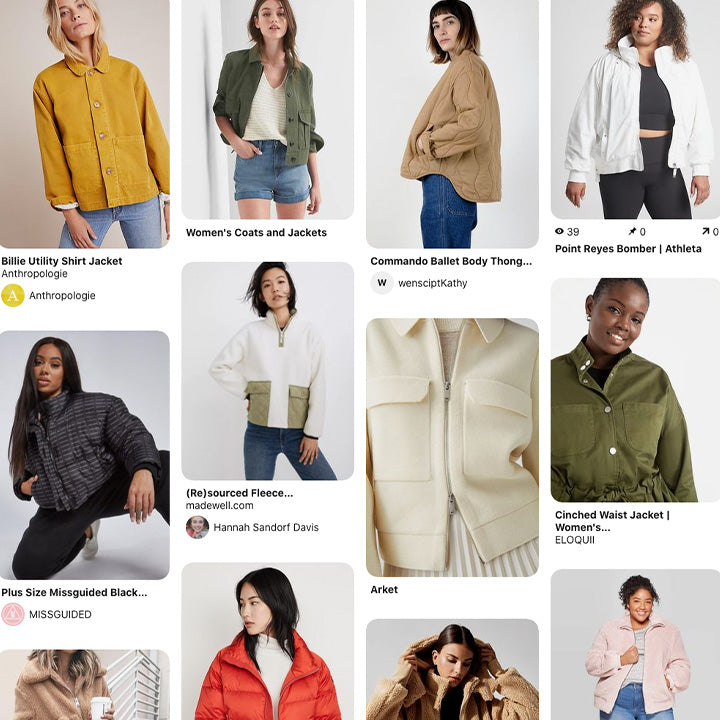
Cozi Jacket Sewalong: Inspiration + Suggested Materials
Last year when I was starting to design the Cozi Jacket, I wanted to offer a classic outerwear shape with an approachable construction. I love sewing outerwear, and had so many ideas pulling me in different directions (I even set the pattern aside for a few months because I just couldn't get to a style I was happy with!). But the inspiration to make this jacket a transitional piece finally struck around the same time I was obsessing over lightweight jackets to carry me through the cool-but-not-cold beautiful Michigan fall. I was very drawn to the military and cropped "shacket" styles, but THEN saw the potential to make it into a cozy winter layering staple when I saw some amazing faux sherpa oversized jackets in the RTW market. The shape of the Cozi jacket is a great base for loads of garment styles, and in the end I decided to keep the style classic and the construction simple to make this piece great for beginners and more experienced sewists alike.
Gathering inspiration
First, be sure to check out the Cozi Jacket Tester Roundup to see what the pattern testers made!
I started a Pinterest Board with all of my favorite transitional jacket images (many of these are super easy hack ideas for the pattern that can be accomplished by simply changing details like pockets, closures, and collars).

Another great thing about this pattern is that it can also be easily made into oversized tees and sweatshirts! Just cut the front bodice on the fold and finish the neckline with a binding.


Be sure to follow the hashtag #pscozijacket to see what others in the sewing community are creating with the pattern as well.
Selecting a fabric
Now that you have a little inspo for which direction to take your Cozi make, let's chat about fabric!
This pattern is designed to be sewn in both wovens and knits, which opens up so many possibilities for the style of this garment.
If using a knit, the fabrics that seemed to work best were ones with lots of texture and a more volume in the drape. Think fleece, faux sherpa fleece, sweatshirt fleece and chunky boucles. This jacket is designed to be a bit oversized and the sturdier knits definitely highlight that feature without making the finished garment look like it's just a a few sizes too big. Volume is your friend with knits on this pattern! These types of knits will also best accommodate a jacket zipper and pockets, as well as create nice support in the collar if sewing version A.

But like I mentioned above, this pattern can easily be hacked into an oversized tee or sweatshirt with really great results. I think this works because you are eliminating most of the detailing (zipper, pockets, collar, and hood) that can weigh down the garment. So if you do plan to go the oversized tee route, most knits that you would normally use here will work really well.
If using a woven for this make, you have a lot of options! Medium weight wovens like denim, canvas, and twill have just enough structure to work with that oversized fit and their crisp hand are a total DREAM for the detailing. These fabrics also wear really well over time, giving you a finished garment that will last years.

I also love the idea of a more fluid tencel twill fabric for this pattern (especially with the gathered hem and sleeve cuffs of Version A). And Linen! Linen would be a beautiful choice and so easy to work with. Either of these options would give you loads of layering flexibility during Spring and Fall (and even cooler summer evenings, depending on what climate you live in).
This pattern is also a fantastic simple base for a quilted garment. I used it as a starting point for my Puffy Coat hack and it has been one of my most favorite and practical makes so far. But even if you didn't want to go all out on a complicated lined coat, you could do a simple quilted shell (or buy pre-quilted fabric) for a really special jacket. It is recommended to size up one to two sizes if making a quilted Cozi.
Here's my puffy coat that I hacked from the Cozi Jacket pattern and a video on how I made it!

Notions
The Cozi features a zip closure along the entire front bodice for both versions, so you'll need to pick up a separating jacket zipper. I prefer metal #3 or #5 zippers (anything over a #5 will be a little heavy for most lightweight jacket applications). You can also use plastic zippers or nylon coil zippers.
I usually buy zippers on wawak.com and really like the ubiquitous YKK brand. The finishes are really nice and the tapes take fabric dye better than other brands I have experimented with.
If sewing Version A, you'll need a basic 2" (5 cm) wide elastic for the waist and sleeve cuffs.
If sewing Version B, you may also want to pick up grommets for the drawstring casing of the hood (1/4" (6 mm) is recommended). And you'll need a drawstring (I usually make my own from fabric scraps).
